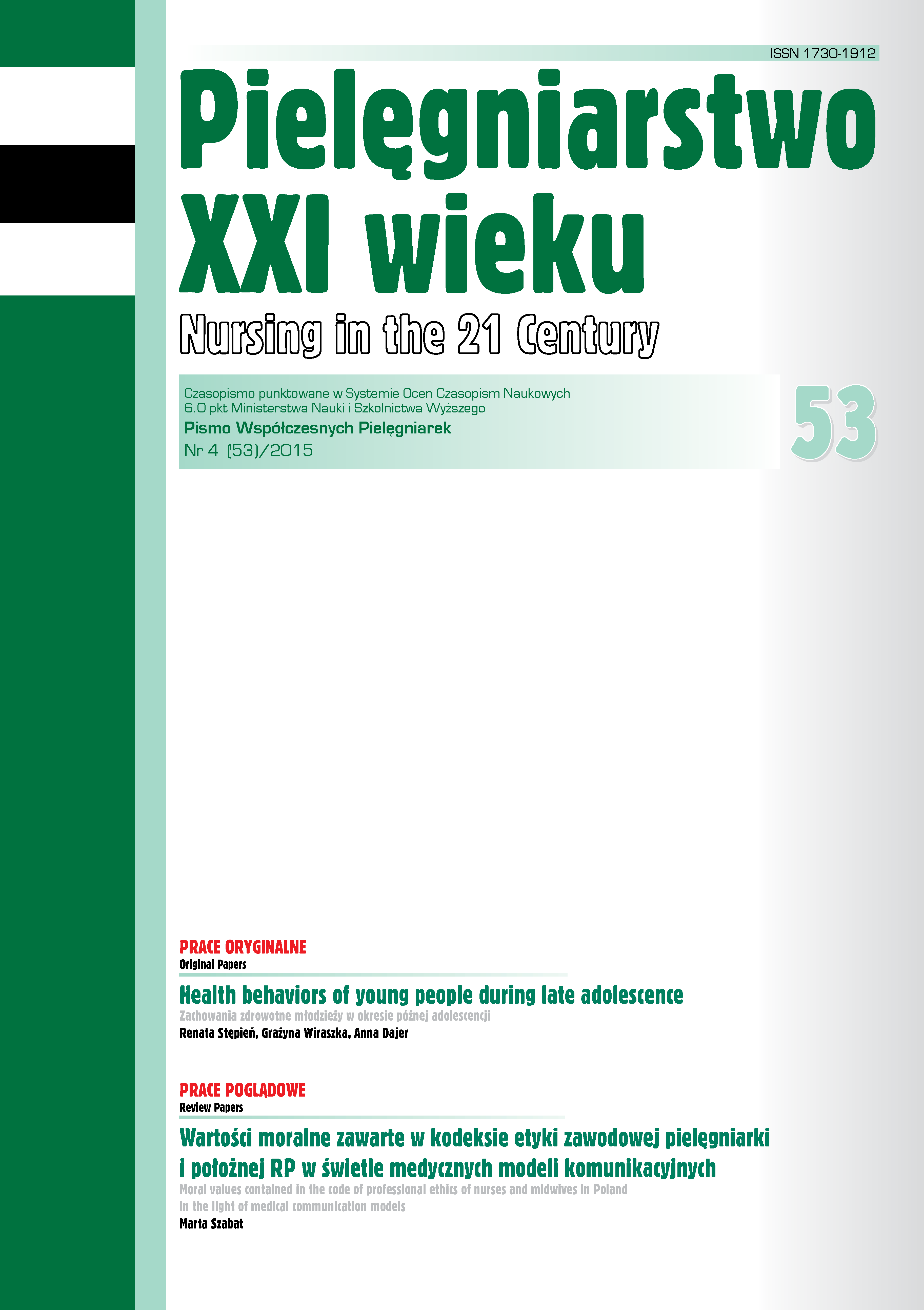The problem of patients' aggression toward health care workers
DOI:
https://doi.org/10.12923/p21w-2015-4/48Keywords:
aggression, workplace violence, nurse, psychiatryAbstract
THE PROBLEM OF PATIENTS' AGGRESSION TOWARD HEALTH CARE WORKERS
Introduction. Aggression and violence in the workplace have become an alarming problem worldwide. They result in disorders which affect both professional and social functioning of victims as well as their mental state. Nurses engaged in direct patient care are especially exposed to aggressive behaviors.
Aim. The purpose of this study was to assess the exposure of health care workers to aggression.
Material and Methodology. The study was carried out in 2014. It included 230 female and male nurses employed in psychiatric hospitals in the Lubuskie Province. This survey-based study was conducted using an original questionnaire “Exposure to aggression” developed at the Unit of Labor Psychology at Prof. J. Nofer Labor Medicine Institute in Łodź.
Results. Some 99.1% of the surveyed faced patient aggression. Its most common form was verbal aggression (shouting – 99.1%). Forms of psychological aggression included: threats (92.2%), offending employees in the presence of their co-workers (89.1%), offending employees in the presence of other patients (87.8%) and blackmail (83.9%). Physical aggression was experienced by 49.1% and attempts of physical attack – 66.5% of the respondents. Education and gender of the surveyed had no statistically significant influence on the exposure to patient aggression. The factors having such influence were: seniority, workplace and age. Employees with the least professional experience and the youngest ones were the most frequent subject to patient aggression. A group at the highest risk of patients’ aggressive behaviors were workers of general psychiatric wards.
Conclusion. Nurses employed at psychiatric wards experience various forms of patients’ aggressive behaviors. The most common form of aggression towards nurses is psychological aggression. The degree of exposure to patient aggression is related to workers’ age, workplace, and seniority. Neither education nor gender has an influence on the exposure to patient aggression.
References
1. Jankowiak B, Kowalczuk K, Krajewska-Kułak E, i wsp. Narażenie położnych na agresję w miejscu pracy – doniesienia wstępne. Ann. Acad. Med. Siles. 2006; 60:405-409.
2. Mościcka A, Drabek M. Agresja i mobbing w środowisku pracy. [w:] Merecz D, red. Profilaktyka psychospołecznych zagrożeń w miejscu pracy – Od teorii do praktyki. Łódź: Wyd. Oficyna wydawnicza Instytutu Medycyny Pracy; 2011.
3. Suwała A. Zjawisko przemocy w zakładach opieki zdrowotnej. Problemy Pielęgniarstwa. 2008; 1691(2): 157-162.
4. Mościcka A, Merecz D. Agresja w miejscu pracy – źródła formy, grupy ryzyka, konsekwencje. Medycyna Pracy. 2003; 54 (4): 361-368.
5. Mościcka A, Merecz D. Jak sobie radzić z agresją w miejscu pracy. Łódź: Instytut Medycyny Pracy im. Prof. J. Nofera. 2002.
6. Kędzia B, Kowalewski S. Przemoc – nowy "czynnik ryzyka zawodowego" w środowisku pracy. Bezpieczeństwo Pracy. 2002; (1): 6-10.
7. Szcześniak D, Rymaszewska J. Agresja pacjenta chorego psychicznie. [w:] Steciwo A, Barański J, Mastalerz – Migas A, red. Agresja w opiece zdrowotnej. Wrocław: Wyd. Urban Partner; 2014. s. 80-84.
8. Stępniak A. Agresja – dwa ujęcia biologiczne. IDO – Ruch dla kultury/Movement for culture. 2009; 9: 111-118.
9. Król E. Agresja – podstawy neurobiologii, zapobiegania i leczenia. Annales Universitis Mariae Curie-Skłodowska. 2000; (26): 127-131.
10. Choak M, Barwiński Ł. Autoagresja jako forma radzenia sobie ze stresem – Przegląd zagadnień. Self Aggression as a form of coping with stess – a review of issues. Psychiatria i Psychoterapia. 2010; 6 (1): 19-30.
11. Ogłodek E. Samouszkodzenia w chorobach psychicznych. Problemy Pielęgniarstwa. 2012; 20 (3): 404 -408.
12. Lickiewicz J, Piątek J. Doświadczanie agresji w pracy pielęgniarki. Sztuka Leczenia. 2014; 3-4: 11-21.
13. Soares JJF, Lawoko S, Nolan P. The nature, extent and determinants of violence against psychiatric personnel. Work and Sress. 2000; 2: 105-120.
14. Berent D, Pierchała O, Florkowski A, i wsp. Agresja pacjentów wobec personelu medycznego Izby Przyjęć Szpitala Psychiatrycznego. Psychiatria i Psychoterapia. 2009; (5): 1-2, 2.
15. Markiewicz R, Łoza B, Sroka M. Zachowania agresywne pacjentów wobec personelu pielęgniarskiego zatrudnionego na oddziałach psychiatrycznych. Neuropsychiatria. Przegląd Kliniczny. 2012; (4) 3: 147-155.
16. Niechwiadowicz – Czapka T. Agresja w pracy pielęgniarki. Magazyn Pielęgniarki i Położnej 2010; 3: http://www.nursing.com.pl/Medinf_agresja_w_pracy_piel%C4%99gniarki_293.html [25.03.2015].
17. Markiewicz R. Patients behavioural aggression against nurses working in psychiatric wards. Health and Wellness. 2014: 159-176.
18. Sariusz-Skąpska M. Formy agresji u pacjentów a wypalenie zawodowe u pracowników placówek psychiatrycznych. Postępy Psychiatrii i Neurologii. 2005; 14, 2: 87-91.
19. Jankowiak B, Krajewska – Kułak E, Krajewska K, i wsp. Agresja i przemoc w pracy pielęgniarki. Pielęgniarstwo XXI wieku. 2005; 3,12: 153-155.
20. Merecz D, Mościcka A. Przemoc w placówkach służby zdrowia i sposoby jej przeciwdziałania. Informator dla pracodawców. Łódź: Instytut Medycyny Pracy, 2003.
21. Skoczylas P. Agresja i przemoc a zdrowie psychiczne. Streszczenie prac z VI Międzynarodowej Konferencji Naukowej. Poznań; 2006.
22. Kostecka M, Żardecka M. Agresja pacjentów placówek psychiatrycznych. Postępy Psychiatrii i Neurologii. 1999; 8: 349-355.
Downloads
Published
Issue
Section
License
Copyright (c) 2015 Anna Jurczak, Anna Włoś, Sylwia Wieder-Huszla, Dorota Branecka-Woźniak, Elżbieta Grochans (Autor)

This work is licensed under a Creative Commons Attribution 4.0 International License.




